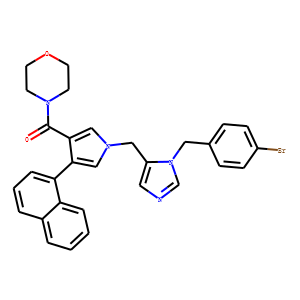| Reference | 1. Int J Oncol. 2014 Oct;45(4):1680-90. doi: 10.3892/ijo.2014.2534. Epub 2014 Jul 4.
<br>
BAI, a novel Cdk inhibitor, enhances farnesyltransferase inhibitor
LB42708-mediated apoptosis in renal carcinoma cells through the downregulation of
Bcl-2 and c-FLIP (L).
<br>
Jang JH(1), Cho YC(2), Kim KH(2), Lee KS(2), Lee J(3), Kim DE(1), Park JS(4),
Jang BC(4), Kim S(1), Kwon TK(1), Park JW(1).
<br>
Author information: <br>
(1)Department of Immunology, School of Medicine, Keimyung University, Daegu,
Republic of Korea.
(2)Department of Urology, Dongguk University, College of Medicine, Gyeongju,
Republic of Korea.
(3)Department of Chemistry, Keimyung University, Daegu, Republic of Korea.
(4)Chronic Disease Research Center, School of Medicine, Keimyung University,
Daegu, Republic of Korea.
<br>
Previously, we reported the potential of a novel Cdk inhibitor,
2-[1,1′-biphenyl]-4-yl-N-[5-(1,1-dioxo-1λ6-isothiazolidin-2-yl)-1H-indazol-3-yl]a
cetamide (BAI) as a cancer chemotherapeutic agent. In this study, we investigated
mechanisms by which BAI modulates FTI-mediated apoptosis in human renal carcinoma
Caki cells. BAI synergizes with FTI to activate DEVDase, cleavage of poly
ADP-ribose polymerase (PARP), and degradation of various anti-apoptotic proteins
in Caki cells. BAI plus LB42708-induced apoptosis was inhibited by pretreatment
with pan-caspase inhibitor, z-VAD-fmk, but not by overexpression of CrmA. The ROS
scavenger, N-acetylcysteine (NAC) did not reduce BAI plus LB4270-induced
apoptosis. Co-treatment of BAI and LB42708 reduced the mitochondrial membrane
potential (MMP, ∆Ψm) in a time-dependent manner, and induced release of AIF and
cytochrome c from mitochondria in Caki cells. Furthermore, BAL plus LB42708
induced downregulation of anti-apoptotic proteins [c-FLIP (L), c-FLIP (s), Bcl-2,
XIAP, and Mcl-1 (L)]. Especially, we found that BAI plus LB42708-induced
apoptosis was significantly attenuated by overexpression of Bcl-2 and partially
blocked by overexpression of c-FLIP (L). Taken together, our results show that
the activity of BAI plus LB42708 modulate multiple components in apoptotic
response of human renal Caki cells, and indicate a potential as combinational
therapeutic agents for preventing cancer such as renal carcinoma.
<br><br>
2. Mol Pharmacol. 2010 Jul;78(1):142-50. doi: 10.1124/mol.110.063586. Epub 2010 Apr
20.
<br>
The farnesyltransferase inhibitor LB42708 suppresses vascular endothelial growth
factor-induced angiogenesis by inhibiting ras-dependent mitogen-activated protein
kinase and phosphatidylinositol 3-kinase/Akt signal pathways.
<br>
Kim CK(1), Choi YK, Lee H, Ha KS, Won MH, Kwon YG, Kim YM.
<br>
Author information: <br>
(1)Department of Molecular and Cellular Biochemistry, School of Medicine, Kangwon
National University, Chuncheon, Kangwon-do 200-701, South Korea.
<br>
Farnesyltransferase (FTase) inhibitors induce growth arrest and apoptosis in
various human cancer cells by inhibiting the post-translational activation of
Ras. FTase inhibitors also function to suppress the release of vascular
endothelial growth factor (VEGF) from tumor cells by inhibiting Ras activation;
however, the effects of FTase inhibitors on VEGF-induced angiogenesis in
endothelial cells have not been studied. We have investigated the antiangiogenic
effect and molecular mechanism of
4-((1-((1-((4-bromophenyl)methyl)-1H-imidazol-5-yl)methyl)-4-(1-napthalenyl)-1H-p
yrrol-3-yl)carbonyl)-(9C1)-morpholine (LB42708), a selective nonpeptidic FTase
inhibitor, using in vitro and in vivo assay systems. LB42708 inhibited
VEGF-induced Ras activation and subsequently suppressed angiogenesis in vitro and
in vivo by blocking the mitogen-activated protein kinase kinase/extracellular
signal-regulated kinase/p38 mitogen-activated protein kinase (MAPK) and
phosphatidylinositol 3-kinase (PI3K)/Akt/endothelial nitric-oxide synthase
pathways in endothelial cells without altering FAK/Src activation. In addition,
this inhibitor suppressed VEGF-induced endothelial cell cycle progression at the
G(1) phase by suppressing cyclin D1 expression and retinoblastoma phosphorylation
as well as up-regulating the cyclin-dependent kinase inhibitors p21 and p27.
Knockdown of Ras by short interfering RNA revealed similar inhibitory effects on
VEGF-induced angiogenic signal events compared with LB42708. Moreover, the
inhibitory effects of LB42708 were significantly higher than those of
4-(2-(4-(8-chloro-3,10-dibromo-6,11-dihydro-5H-benzo-(5,6)-cyclohepta(1,2-b)-pyri
din-11(R)-yl)-1-piperidinyl)-2-oxo-ethyl)-1-piperidinecarboxamide (SCH66336), a
well known FTase inhibitor. LB42708 suppressed tumor growth and tumor
angiogenesis in both xenograft tumor models of Ras-mutated HCT116 cells and its
wild-type Caco-2 cells, indicating its potential application in the treatment of
both Ras-mutated and wild type tumors. These data indicate that the antitumor
effect of LB42708 can be associated with direct inhibition of VEGF-induced tumor
angiogenesis by blocking Ras-dependent MAPK and PI3K/Akt signal pathways in
tumor-associated endothelial cells.
<br><br>
3. Toxicol Appl Pharmacol. 2006 Sep 15;215(3):317-29. Epub 2006 May 19.
<br>
The farnesyltransferase inhibitor, LB42708, inhibits growth and induces apoptosis
irreversibly in H-ras and K-ras-transformed rat intestinal epithelial cells.
<br>
Kim HS(1), Kim JW, Gang J, Wen J, Koh SS, Koh JS, Chung HH, Song SY.
<br>
Author information: <br>
(1)Brain Korea 21 Project for Medical Science, Yonsei University College of
Medicine, Seoul, Republic of Korea.
<br>
LB42708 (LB7) and LB42908 (LB9) are pyrrole-based orally active
farnesyltransferase inhibitors (FTIs) that have similar structures. The in vitro
potencies of these compounds against FTase and GGTase I are remarkably similar,
and yet they display different activity in apoptosis induction and morphological
reversion of ras-transformed rat intestinal epithelial (RIE) cells. Both FTIs
induced cell death despite K-ras prenylation, implying the participation of
Ras-independent mechanism(s). Growth inhibition by these two FTIs was accompanied
by G1 and G2/M cell cycle arrests in H-ras and K-ras-transformed RIE cells,
respectively. We identified three key markers, p21(CIP1/WAF1), RhoB and EGFR,
that can explain the differences in the molecular mechanism of action between two
FTIs. Only LB7 induced the upregulation of p21(CIP1/WAF1) and RhoB above the
basal level that led to the cell cycle arrest and to distinct morphological
alterations of ras-transformed RIE cells. Both FTIs successfully inhibited the
ERK and activated JNK in RIE/K-ras cells. While the addition of conditioned
medium from RIE/K-ras reversed the growth inhibition of ras-transformed RIE cells
by LB9, it failed to overcome the growth inhibitory effect of LB7 in both H-ras-
and K-ras-transformed RIE cells. We found that LB7, but not LB9, decreased the
expression of EGFRs that confers the cellular unresponsiveness to EGFR ligands.
These results suggest that LB7 causes the induction of p21(CIP1/WAF1) and RhoB
and downregulation of EGFR that may serve as critical steps in the mechanism by
which FTIs trigger irreversible inhibitions on the cell growth and apoptosis in
ras-transformed cells.
<br>
|

